Yellow Lawn Care: Reasons And Fixes For Yellow Lawns
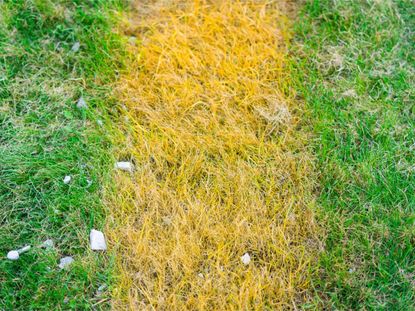

The suburban dream often includes deeply green, verdant lawn grass on which gardeners spend a lot of time and money. Mechanical maintenance, pest and disease prevention, insect control, and deep, consistent watering are essential. But even after all this work and expense, grass still sometimes turns yellow. What can you do about it?
Reasons Your Grass Is Turning Yellow
Yellowing grass can be a sign of a number of issues. Read all about fixes for yellow grass.
Grass Type
Some grasses are naturally greener than others. Kentucky bluegrass has a nice deep green color, while others have a lighter tinge. Another consideration is seasonality, since warm season grasses turn yellowish brown in the cooler months. It’s also possible that turfgrass will turn yellow and go dormant in stressed conditions such as hot, dry summers. Zoysia and St. Augustine are warm season grasses with a normally light green hue.
Cool season grasses will go dormant as the cold season hits, and assume a yellowish green color. Tall and fine fescues, Kentucky bluegrass, and perennial ryegrass are examples of cool season grasses.
Watering Too Much or Too Little
Water drives all plant growth, including sod. It is not uncommon to find yellow, new leaf blades after spring rains, which produce rapid growth. The chlorophyll content in these new leaves is diluted, making them appear yellower than older, greener blades.
Watering a lawn on an irregular schedule can also cause parts of it to yellow, as can having areas that don’t get enough water. After mowing, the taller, greener leaves are mowed off and the lower, yellow leaves exposed. These lower leaves have not received as much sunlight and therefore are not producing as much chlorophyll. The entire effect gives the lawn a gold green rather than deep green appearance.
Soil is too Compacted
Turfgrass site preparation is very important to a healthy lawn. Soil that does not percolate well, has insufficient nutrient and mineral content, and has poor pH can produce discolored leaf blades.
Gardening tips, videos, info and more delivered right to your inbox!
Sign up for the Gardening Know How newsletter today and receive a free download of our most popular eBook "How to Grow Delicious Tomatoes."
Soil compaction interferes with drainage and proper root growth. Compacted soil cannot easily transport water, air, and nutrients to plant roots, which can cause poor sod health and yellowing in the leaf blades. The buildup of carbon dioxide can damage grass roots, resulting in discoloration. Core lawn aeration is an excellent way to increase percolation and air exchange to the roots.
Dormancy
Warm season grasses will experience dormancy when temperatures get cool. Dormancy is a period of rest that allows the grass to regrow each year, and turns the blades from tan to yellow. Once temperatures warm up and adequate water is administered, the grass’s leaves will green up again.
Similarly, cool season grasses stop active growth in fall to winter. These types of lawns are typical in the Pacific Northwest and other temperate to cool regions. The change in color is normal for each grass in the associated season.
Lawn Nutrient Deficiency
Turfgrasses like to be fed. They need a high quantity of nitrogen to drive all their foliar growth. But often yellowing grass occurs not because of lack of nitrogen, but because of an iron deficiency. This is often exhibited when the plant is coming out of dormancy and water is plentiful. The condition is called iron chlorosis and means the roots aren’t getting enough iron to produce healthy new shoots. This yellowing is at the top of the turf rather than the bottom, as in the case of yellowing caused by too much water.
An application of iron chelate will take care of iron deficiency in soil. But if the yellowing is caused by lack of nitrogen, applications of iron will not help. It will green up the older blades but the new growth will still be yellow.
Mowing Mistakes
Scalping is an accurate and picturesque term for mowing too low. Once an area is scalped, it will yellow. This is because the plant is so busy growing new leaves to replace the ones removed, it cannot provide ample iron for the new growth. Additionally, the removal of too many leaves means the plant doesn’t have enough to drive photosynthesis and produce chlorophyll. Raise the deck of your mower and mow higher but frequently to prevent scalping and thatch buildup.
Grubs and Pests
There seems to be an infinite number of insects and grubs that like snacking on the lawn. Chinch bugs are most damaging in summer. They feed on leaf blades, sucking the sap out of the leaf and causing it to fail. Patches of yellowish brown sod grass are indicators of chinch bug activity.
The feeding activity of the grubs of Japanese beetles and other beetles causes lawn discoloration. The presence of wild animals and birds digging in the lawn looking for lawn grubs is an early clue. So too, are patches of brown-yellow lawn. Stressed lawns are more affected than those that are properly mown, irrigated, and fed. Certain insecticides for lawns can help control these insects.
Diseases
Probably the biggest group of diseases that cause a yellow lawn are the fungi. Turf grass rust causes leaves to develop patchy, yellow spots. Over time, these fungal lesions will broaden, causing the entire leaf to pale. Orange spores are present by the time the fungus has matured. Some other common fungi that can cause problems include fairy rings, snow mold, fusarium and smut.
Grass leaves that remain wet for long periods during midsummer promote the formation of spores. They are also very transmissible and move from foot traffic and mowing. Yellow patches occur during wet, cloudy, cool weather. Heavy soil, excess nitrogen, thick thatch, and poor drainage speed the movement of the fungus. Good cultural and management practices can slow or diminish the spread of these fungi. In certain cases, a soil fungicide drench will prevent contagion.
Overfertilization
While lawn fertilization is recommended for overall health, an abundance of one nutrient or another can cause an unwanted response. While nitrogen is a necessary nutrient for a healthy lawn, excess nitrogen causes an abundance of nitrogen salts. Accumulation of these salts reduces available moisture to the grasses roots. Too much nitrogen will also change the soil’s pH, which prevents plants from uptaking certain minerals. A quick release fertilizer is more likely to produce buildup. Watering after fertilization can minimize this root burn.
Other Reasons Your Lawn Is Turning Yellow
During the summer many of us have yellow lawns due to our efforts to conserve water. Drought conditions make this a logical and sometimes required practice.
Dog urine, which contains a high level of nitrogen, can cause burn spots in the lawn. These are easily recognized as yellow spots bordered by greener grass. This is because the diluted edges of the urine area are actually feeding the grass, but the concentrated center is burning the roots.
Another potential cause is heat and sunlight. Excessively hot weather and areas that are exposed to full sun all day will dry out quickly, and the heat stresses the lawn. This results in yellow areas. Watering more frequently and deeply will usually correct the issue.
Yellowing Lawn Fixes
You may need to get down and take a close look between blades of grass and the soil beneath them to determine whether pests or fungus are at the root of your yellowing lawn.
The easiest cure is to give the lawn good care and enhance its vigor and health so it has the strength to combat any pest or disease problems. Here are some ideas:
- Thin out trees so plenty of sunlight can get into the area.
- Maintain a sharp mower and only mow when the grass is dry.
- Improve drainage in the lawn and aerate to increase air circulation to roots.
- Rake up excess grass clippings which can make a home for pests and harbor disease. The same goes for fallen leaves.
- Water deeply, but infrequently, in the morning when leaf blades will have time to dry.
- Fertilize as recommended and watch for weed competitors which can suck resources from the lawn.

Bonnie Grant is a professional landscaper with a Certification in Urban Gardening. She has been gardening and writing for 15 years. A former professional chef, she has a passion for edible landscaping.
-
 Monkey Orchid Care: How To Grow This Fascinating Species
Monkey Orchid Care: How To Grow This Fascinating SpeciesThe monkey orchid bears a remarkable resemblance to its namesake and, with a little know-how, can be successfully grown as a houseplant.
By Bonnie L. Grant
-
 How To Grow Garden To Table: A Guide For Home Cooks
How To Grow Garden To Table: A Guide For Home CooksWhat could be better than a meal that comes directly from garden to table? Show off your gardening and culinary skills with the very freshest food.
By Bonnie L. Grant
-
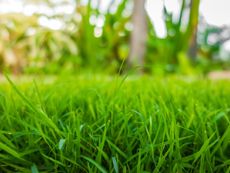 Sustainable Turf Species For A Greener Lawn
Sustainable Turf Species For A Greener LawnClick here for some of the most sustainable types of turf grass you can grow for an eco-friendly lawn.
By Bonnie L. Grant
-
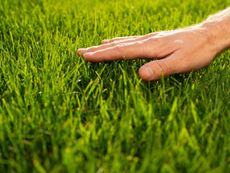 How To Grow A Sustainable Lawn
How To Grow A Sustainable LawnAdjust your thinking about a perfect green lawn and consider more sustainable methods. Click here to learn how.
By Mary Ellen Ellis
-
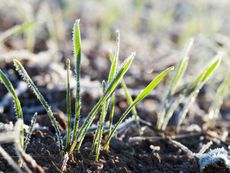 Will Frost Kill Grass Seed And How To Help New Turf Survive
Will Frost Kill Grass Seed And How To Help New Turf SurviveLearn how to help your newly sown grass survive frost and freezing weather.
By Amy Grant
-
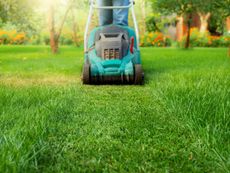 Lawn Problems That Aren’t Really Problems
Lawn Problems That Aren’t Really ProblemsYour lawn may not require as much work as you think. Learn which common problems aren’t really problems.
By Teo Spengler
-
 Why A Manual Push Mower Is Good For You And The Environment
Why A Manual Push Mower Is Good For You And The EnvironmentReel mowers are making a comeback, but why? Click here to learn about reel mower pros and cons.
By Amy Grant
-
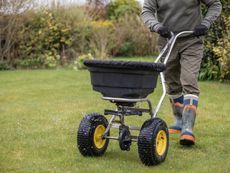 Fertilize Grass In Fall For A Lush Lawn In Spring
Fertilize Grass In Fall For A Lush Lawn In SpringFor everything you need to know about fertilizing your lawn in the fall, click here.
By Susan Albert
-
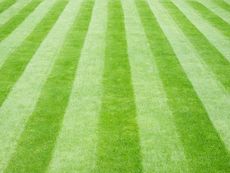 Tips For Mowing Stripes In Lawn
Tips For Mowing Stripes In LawnWouldn’t it be great to have stripes in your lawn like a sports field? Learn how here.
By Susan Albert
-
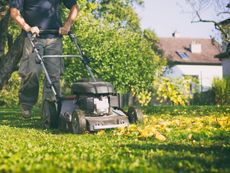 Late Summer Lawn Care Checklist
Late Summer Lawn Care ChecklistPlan to do some late summer care and maintenance of your lawn so it will be healthy and beautiful in the spring. Here are some tips.
By Laura Miller